Back to blog
19 MIN READ
11 SaaS Product Adoption Strategies with Practical Examples
PUBLISHED
24 February, 2025

Product Analytics Expert
You’ve built a great SaaS product. People sign up, but weeks later, most never return. Your dashboard is filled with inactive users, free trials that don’t convert, and customers who barely scratch the surface of your features before churning.
It’s not that your product lacks value, it’s that users never experience it fast enough. They get stuck, overwhelmed, or simply don’t see why it’s worth their time. Without a strong SaaS product adoption strategy, your retention drops, growth stalls, and marketing efforts go to waste.
So, how do you turn sign-ups into engaged, long-term users? This guide will walk you through proven, actionable strategies to drive adoption, keep users engaged, and make your product an essential part of their workflow. Let’s get started.
Summary - 11 SaaS product adoption strategy
| Strategy | Description |
|---|---|
| Design a Frictionless Onboarding Flow | Ensure users quickly grasp value, reducing drop-offs and increasing engagement. |
| Make Customer Education a Priority | Provide in-app guides, webinars, and forums for confident product usage. |
| Use Personalization to Drive Engagement | Customize dashboards and recommend features based on user behavior. |
| Improve Product Discoverability | Simplify navigation with logical menus and robust search functions. |
| Leverage In-App Messaging | Use behavior-triggered prompts to guide, engage, and collect feedback. |
| Track the Right Adoption Metrics | Monitor DAU/MAU, feature usage, and conversion funnel drop-offs. |
| Create Feedback Loops | Use surveys and beta testing to gather and act on user input. |
| Keep Users Engaged with Updates | Share product roadmaps, release incremental improvements, and communicate changes. |
| Simplify Feature Adoption | Provide in-app announcements, tutorials, and milestone-based tracking. |
| Reduce Friction in the User Journey | Remove unnecessary steps, offer self-service help, and ensure consistency. |
| Encourage Power Users | Identify, engage, and incentivize referrals and user-generated content. |
What is SaaS product adoption?
SaaS product adoption is the process where users go from signing up to actively using your software as part of their workflow. It’s not just about getting new users—it’s about making sure they stick around, engage deeply, and consistently find value in your product.
Adoption isn’t the same as registration. Just because someone creates an account doesn’t mean they’re using your product. Many users sign up, explore for a few minutes, and never return. True adoption happens when your product becomes essential to their daily tasks.
To drive adoption, you need to align users with the right features at the right time. If users don’t quickly experience value, they disengage. The key is guiding them to the aha moment—the point where they realize exactly how your product makes their work easier.
Successful SaaS adoption leads to higher retention, lower churn, and increased expansion revenue. The faster users integrate your product into their workflow, the more likely they are to stay, upgrade, and become advocates.
In the next section, we’ll explore why product managers should prioritize adoption and how it directly impacts business growth.
Why should you prioritize SaaS product adoption?
You can build the most powerful SaaS product, but if users don’t adopt it, nothing else matters. High acquisition numbers won’t save you if users sign up, get frustrated, and leave. Adoption is the foundation of product-led growth, retention, and long-term revenue.
When users fully adopt your product, they integrate it into their daily workflow. This means fewer cancellations, higher engagement, and more opportunities for expansion. The stronger the adoption, the easier it becomes to reduce churn and increase customer lifetime value (LTV).
Adoption fuels retention and expansion
Retention is the heartbeat of a successful SaaS business. If users don’t find value quickly, they’ll churn. But when users reach that aha moment—the point where your product solves a real problem—they’re more likely to stay, upgrade, and invest in additional features.
A well-adopted product also opens the door for expansion revenue. When users actively engage with your core features, they’re more likely to explore premium functionalities, integrations, and add-ons. This makes upselling and cross-selling a natural progression instead of a hard sell.
Engaged users become advocates
Users who love your product won’t just stick around, they’ll talk about it. High adoption turns customers into brand advocates, leading to organic referrals, positive reviews, and stronger word-of-mouth marketing.
Happy users share their experiences on social media, recommend your product to peers, and influence buying decisions within their networks. This lowers your customer acquisition cost (CAC) and brings in new users who are already primed for adoption.
Adoption is a product manager’s competitive edge
SaaS markets are crowded. If your product doesn’t drive adoption, users will switch to an alternative that does. A seamless onboarding experience, continuous value delivery, and proactive user engagement help you stay ahead of competitors and increase market share.
Strategies to increase adoption in your SaaS product
You’ve convinced users to sign up, now the real challenge begins. Will they engage, find value, and stick around? Or will they abandon your product after a few clicks?
SaaS product adoption is all about helping users succeed so they want to stay. Every interaction should guide them closer to that aha moment, where your product becomes indispensable.
Here’s how you can make it that happen.
1. Design a frictionless onboarding flow
Your onboarding experience is the difference between an engaged user and a lost opportunity. If users can’t figure out how to use your product within the first few minutes, they’ll abandon it no matter how powerful it is.
A well-designed onboarding flow should remove friction, reduce cognitive load, and guide users toward success. Here’s how to do it effectively:
Guide users with interactive tooltips and product tours
Dumping new users into a blank dashboard with no direction is a surefire way to lose them. Instead, use interactive tooltips and guided product tours to help them navigate key features.
Progressive disclosure: Reveal features step by step, avoiding information overload.
Contextual guidance: Display tooltips only when users interact with relevant sections.
Skip option: Give experienced users the choice to bypass guided tours.
For example, Slack introduces its core features progressively, allowing users to explore at their own pace without feeling overwhelmed.
Let users personalize their setup
Not all users have the same workflow. Let them customize their experience from day one.
Enable dashboard customization with widgets and pinned features.
Allow users to adjust notification settings to suit their preferences.
Offer role-based onboarding, tailoring the setup process based on user roles (e.g., admin vs. team member).
Personalization helps users feel ownership over the product, making them more likely to engage and return.
Deliver quick wins to show immediate value
Users should experience a tangible benefit within their first session. Guide them to their aha moment, where they immediately see how your product solves their problem.
Highlight a core feature that addresses an immediate need.
Use pre-filled sample data or templates to eliminate empty states.
Implement goal-based onboarding, where users complete small actions that lead to meaningful outcomes.
For instance, Canva’s onboarding instantly provides users with editable design templates, ensuring they see results in minutes—boosting early engagement and adoption.
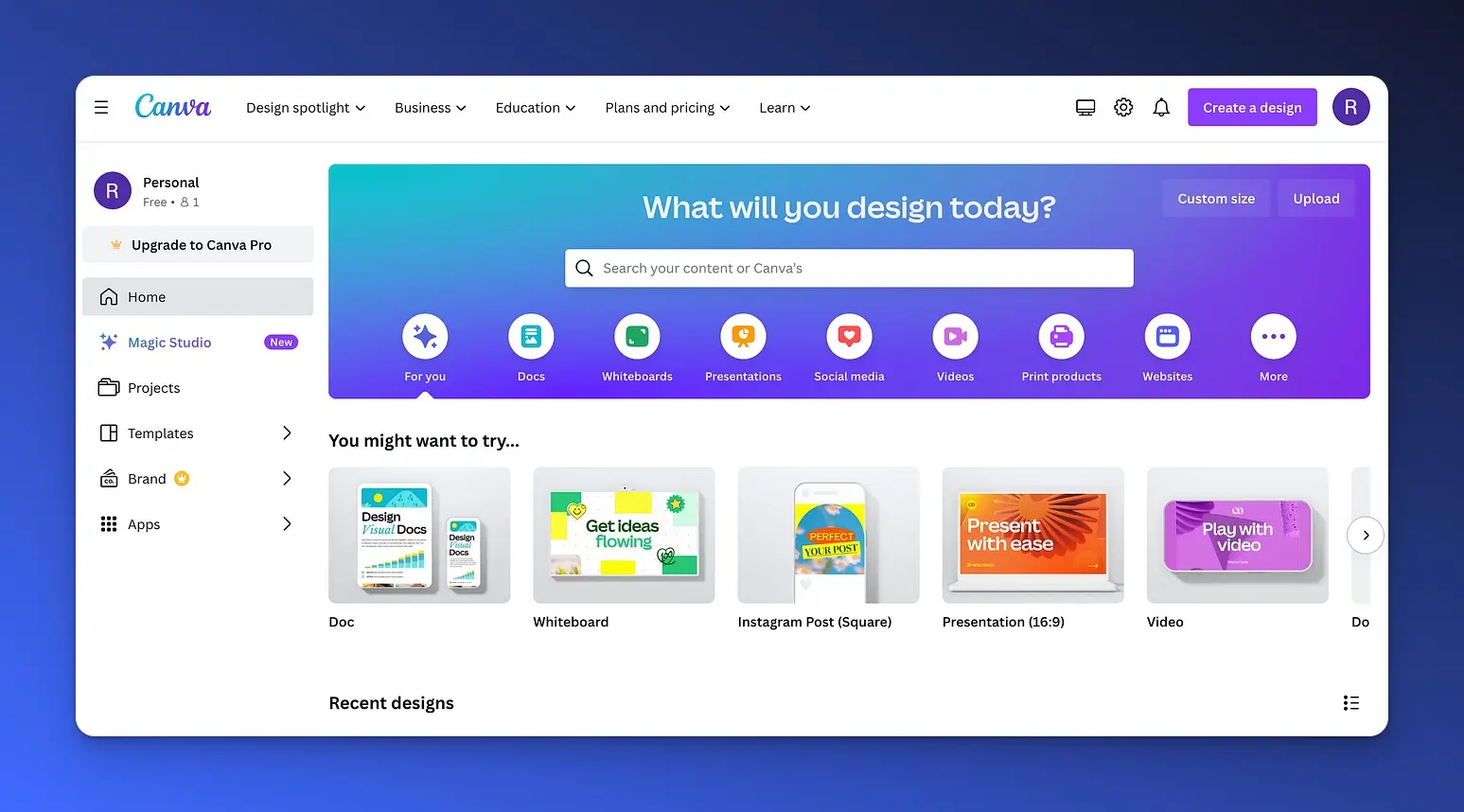
2. Track the right adoption metrics
SaaS product adoption isn’t about gut feelings—it’s about data-driven decisions. If you’re not tracking the right metrics, you won’t know what’s working and what needs fixing.
To optimize adoption, focus on key indicators that reveal user engagement, feature adoption, and friction points.
Monitor DAU/MAU to measure engagement trends
Daily and monthly active users (DAU/MAU) show you how often users return. A low DAU/MAU ratio means users aren’t engaging consistently—a sign they aren’t finding enough value.
If DAU is dropping, examine whether onboarding is too complex or feature adoption is low.
Compare DAU/MAU over time to see if users stick around after sign-up.
Segment data by user cohorts (e.g., new vs. existing users) to uncover trends in long-term engagement.
Analyze feature usage rates to identify underutilized tools
Not all features are equally valuable to users. If a key feature has low adoption, it could mean:
Users don’t understand its purpose.
It’s too difficult to access or set up.
There’s no clear benefit shown during onboarding.
Tracking feature usage analytics helps you spot underperforming tools and refine your product positioning and onboarding flow.
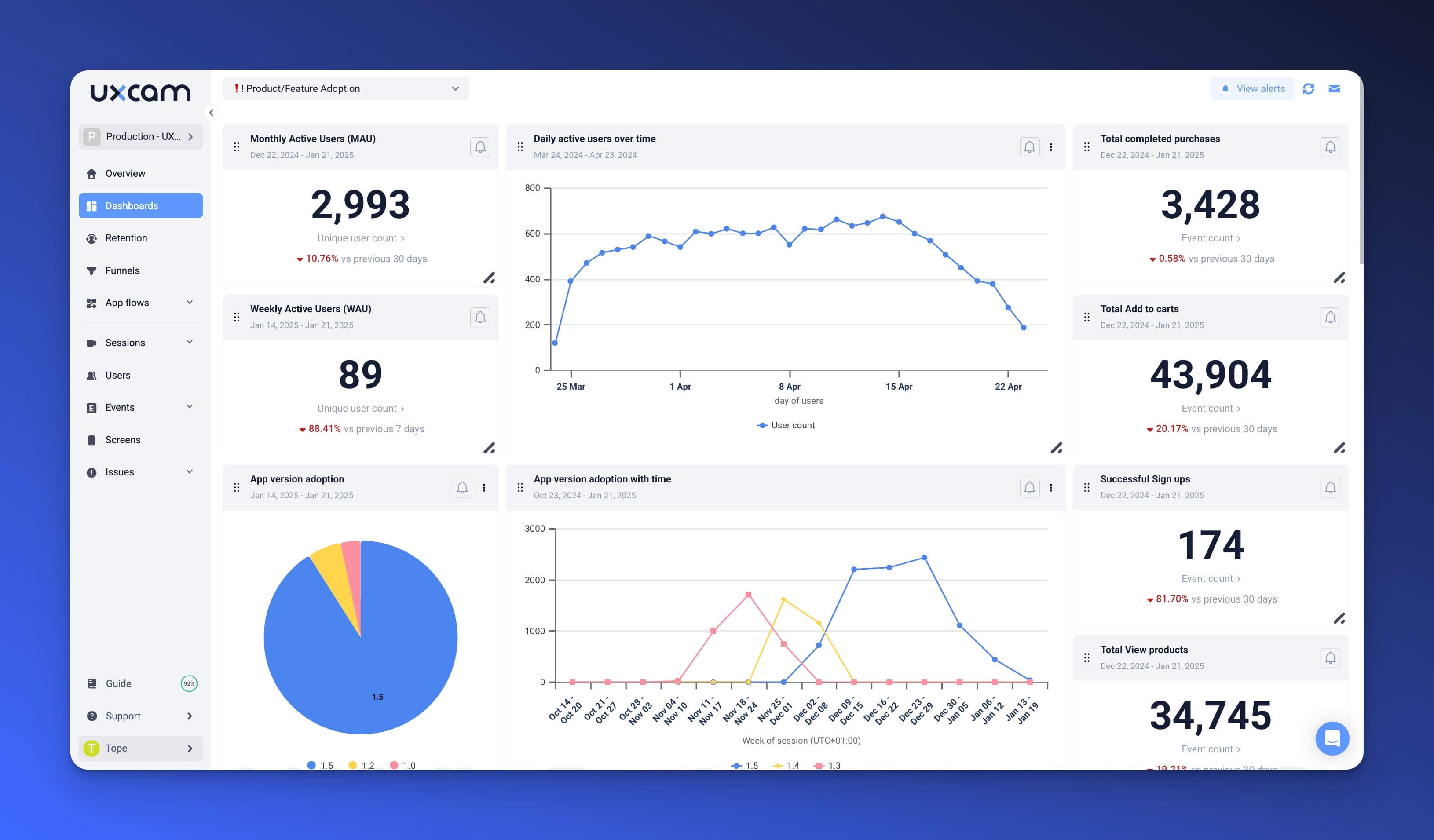

Assess conversion funnel drop-offs to detect friction points
If users abandon your product at key stages (e.g., during onboarding or setup), something is blocking adoption. Session replay and funnel analysis can reveal:
Where users drop off during sign-up or onboarding.
If they attempt but fail to complete certain tasks.
Which steps cause confusion or frustration.
For example, if many users drop off right before activating an integration, there may be a missing tutorial or an unnecessary step creating friction.
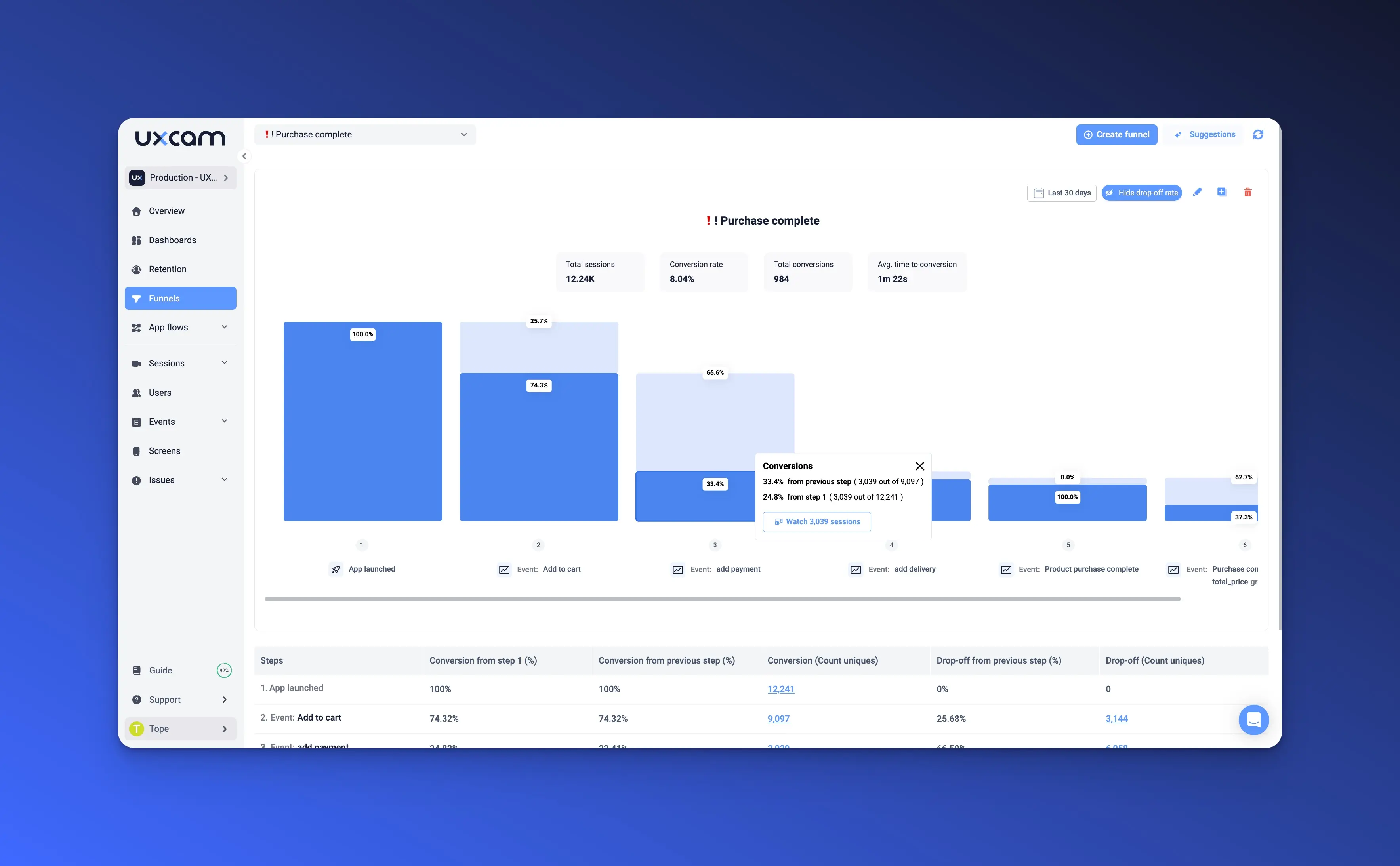
By continuously tracking adoption metrics, you can pinpoint where users struggle, refine your onboarding strategy, and keep engagement high.
3. Make customer education a priority
Even the most intuitive SaaS products require guidance. If users don’t understand how to get the most out of your product, they’ll abandon it or only use a fraction of its features. The challenge? Users won’t spend time searching for answers—they expect help to be immediate and accessible.
Effective customer education removes guesswork and reduces frustration, making it easier for users to adopt your product. Here’s how to make learning effortless:
Build an in-app knowledge base for instant answers
Users won’t open a 20-page help doc when they hit a roadblock. They need bite-sized, searchable answers within the app.
Create tooltips, pop-ups, and hover-over explanations for complex features.
Offer an AI-powered search bar in your help center to surface the right articles instantly.
Use video tutorials and GIFs instead of long, text-heavy documentation.
For example, Clochshark embeds quick how-to videos within the app, so users don’t have to leave the platform to learn.
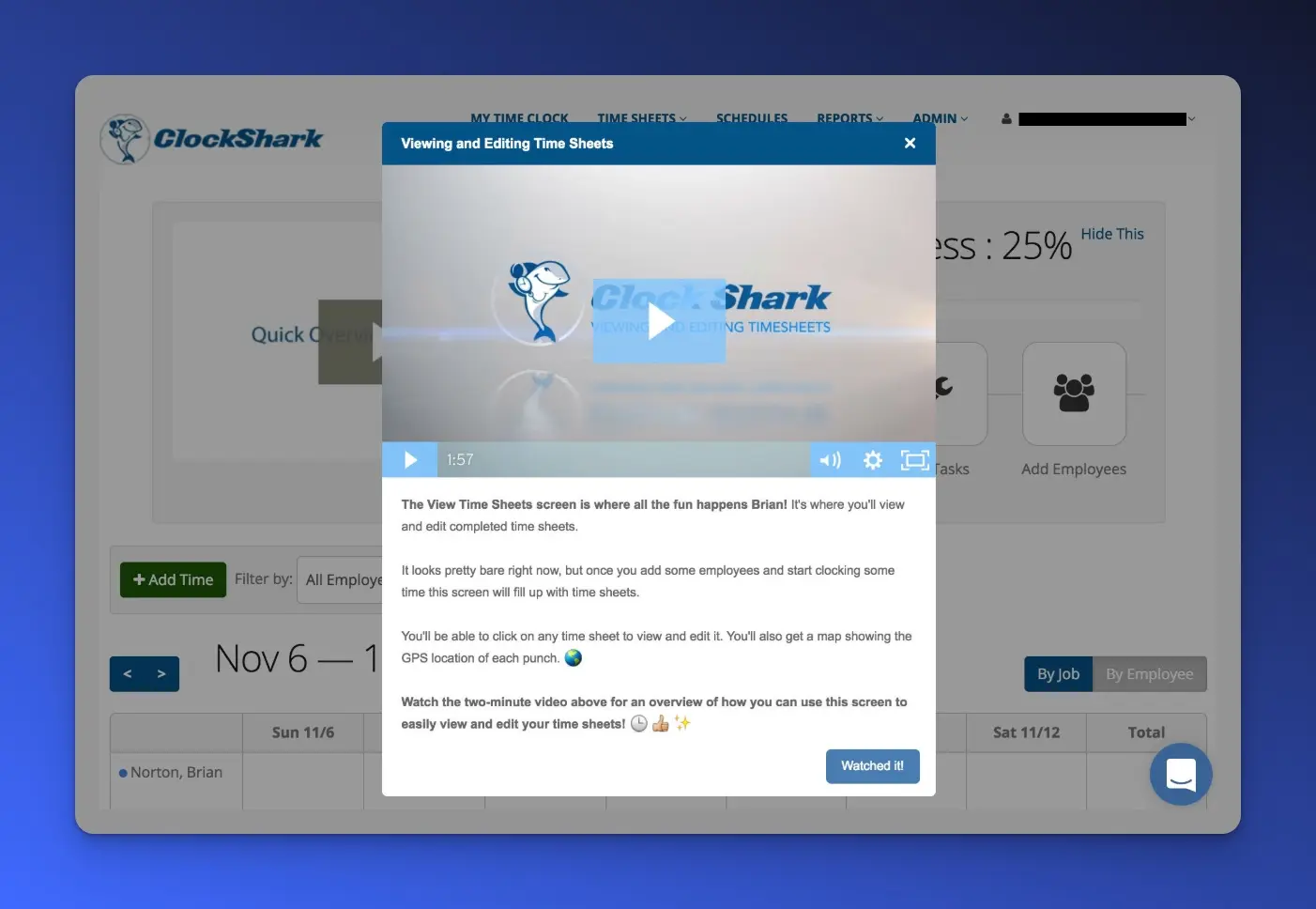
Host live webinars and training sessions
Some users, especially enterprise customers, require hands-on guidance to unlock your product’s full potential.
Run monthly live webinars on key use cases and advanced features.
Offer one-on-one onboarding calls for high-value accounts.
Create pre-recorded video tutorials so users can learn on their own schedule.
HubSpot does this well by providing free live training and certification programs, making users feel more invested in the platform.
Foster a user community for peer learning
Your most engaged users can be your best educators. A strong user community helps customers solve problems faster and discover new use cases from real-world experiences.
Create a Slack or Discord community where users can share best practices.
Host a forum or LinkedIn group where customers discuss workflows and troubleshooting.
Recognize power users and encourage them to contribute guides, FAQs, or case studies.
For example, Figma’s community forums allow designers to share tips, templates, and hacks, helping new users get up to speed faster.
4. Use personalization to drive engagement
Not all users interact with your product the same way. Some are power users who want advanced features upfront, while others need a simpler experience to get started. If you treat everyone the same, engagement suffers.
Personalization ensures that each user sees what matters most to them, making it easier to find value and integrate your product into their workflow. Here’s how to do it effectively:
Enable users to customize dashboards
Users should feel like your product adapts to them—not the other way around. Giving them control over their dashboard layout, widgets, and pinned features ensures they can focus on what’s most relevant.
Allow users to drag and drop widgets to personalize their workspace.
Let them set preferences for reports, notifications, and views to reduce clutter.
Offer pre-configured templates based on common use cases to accelerate setup.
A product analytics tool like UXCam allows you to create customizable dashboards, enabling you to tailor your insights to your business needs and make data-driven decisions.
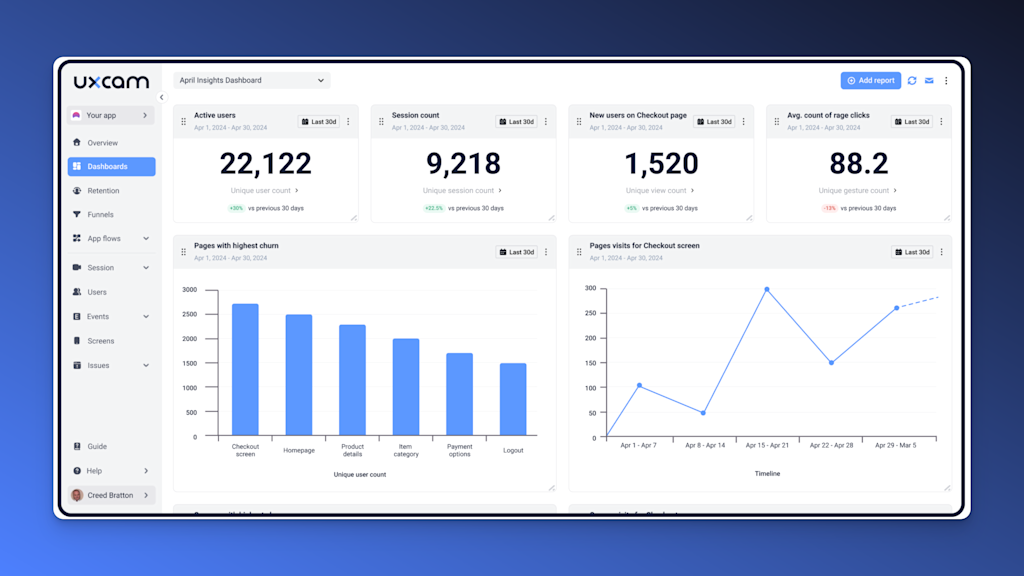

Recommend relevant features based on user behavior
Most users won’t explore your entire feature set on their own. Smart recommendations guide them toward the tools that will benefit them the most.
Use behavior-based prompts to suggest features they haven’t tried but align with their usage patterns.
Display in-app nudges when users complete certain actions, leading them naturally to the next step.
Surface contextual tooltips highlighting underutilized features when relevant.
For example, UXCam’s product analytics for web can track user behavior and surface insights on where users struggle, helping you refine recommendations.
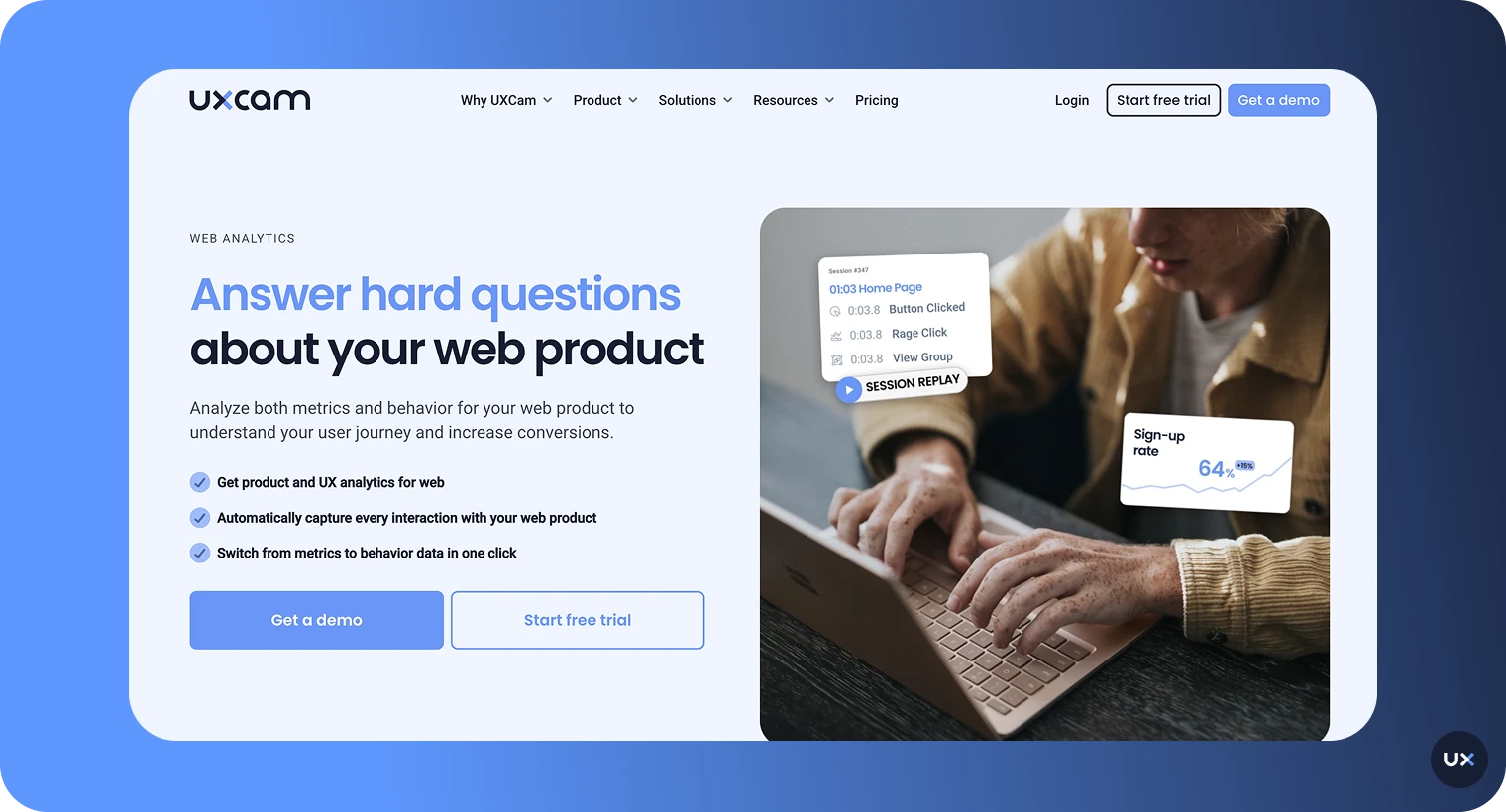
Adapt messaging and onboarding based on user roles
A product manager, a developer, and a marketing executive will use your product differently. Your onboarding experience and in-app messaging should reflect that.
Ask users their role or goals during signup to customize their onboarding journey.
Show role-specific tooltips and feature recommendations to match their needs.
Use segmented email campaigns to send relevant educational content based on how they engage with your product.
Products like HubSpot and Asana do this well, ensuring that users only see the features and workflows that matter to them.
5. Improve product discoverability with intuitive navigation
Your product might have powerful features, but if users can’t find them easily, they won’t use them. Poor navigation creates frustration, slows down adoption, and increases churn.
Making your product intuitive and easy to explore ensures that users quickly find what they need and uncover valuable features along the way.
Structure menus logically for easier exploration
If users struggle to find key features, they’ll assume they don’t exist. A well-organized menu reduces cognitive load and makes navigation effortless.
Group related features into clear, logical categories to prevent overwhelm.
Minimize nested menus—important features should never be buried under multiple clicks.
Use familiar terms and labels instead of technical jargon to improve clarity.
For example, Notion’s sidebar menu is structured to help users quickly navigate between workspaces, documents, and databases without confusion.
Offer advanced search and filtering
A strong search function helps users find exactly what they need, fast, especially in products with a lot of data, reports, or content.
Implement predictive search that suggests results as users type.
Allow filtering by categories, dates, or user activity to refine searches.
Use synonyms and natural language processing (NLP) so users don’t have to guess exact keywords.
For example, Slack�’s search function lets users find messages, files, and channels instantly, improving workflow efficiency.
Use user feedback to continuously improve navigation
Navigation isn’t static. As your product evolves, your menu structure and search functionality should adapt based on real user behavior and feedback.
Monitor session recordings and heatmaps to see where users struggle to find features.
Collect feedback through in-app surveys asking users about their navigation experience.
A/B test menu layouts and search enhancements to improve usability over time.
6. Leverage in-app messaging for timely engagement
Most users don’t explore your product on their own. If they miss key features or get stuck, they’re unlikely to reach out for help—they’ll just stop using your product. This is where in-app messaging can make all the difference.
Well-timed, contextual messages guide users through their journey, helping them discover value without feeling overwhelmed. Instead of waiting for users to take action, meet them where they are and nudge them forward.
Use behavior-triggered prompts to guide users
A one-size-fits-all onboarding email won’t help a user struggling in-app. Instead, trigger messages based on real user behavior to provide relevant, real-time guidance.
If a user repeatedly visits a page but doesn’t take action, prompt them with a tooltip or explainer video.
If they abandon a setup process, send a friendly reminder or checklist to complete it.
If they interact with a feature for the first time, display a short walkthrough or best practice tip.
For example, Notion provides in-app nudges when users explore templates, showing how to make the most of them without disrupting their workflow.
Nudge inactive users toward activating key features
Many users sign up but never fully activate. They may complete a few actions, then disappear—often because they never realized the product’s full value.
Use in-app pop-ups to remind users of important features they haven’t set up yet.
Send a gentle nudge when users haven’t logged in for a few days, highlighting unfinished tasks or milestones.
Offer personalized tips based on what they’ve already completed, encouraging them to take the next step.
For instance, UXCam’s session replay feature can identify where users drop off, allowing teams to trigger nudges at the right time to bring them back into the product.
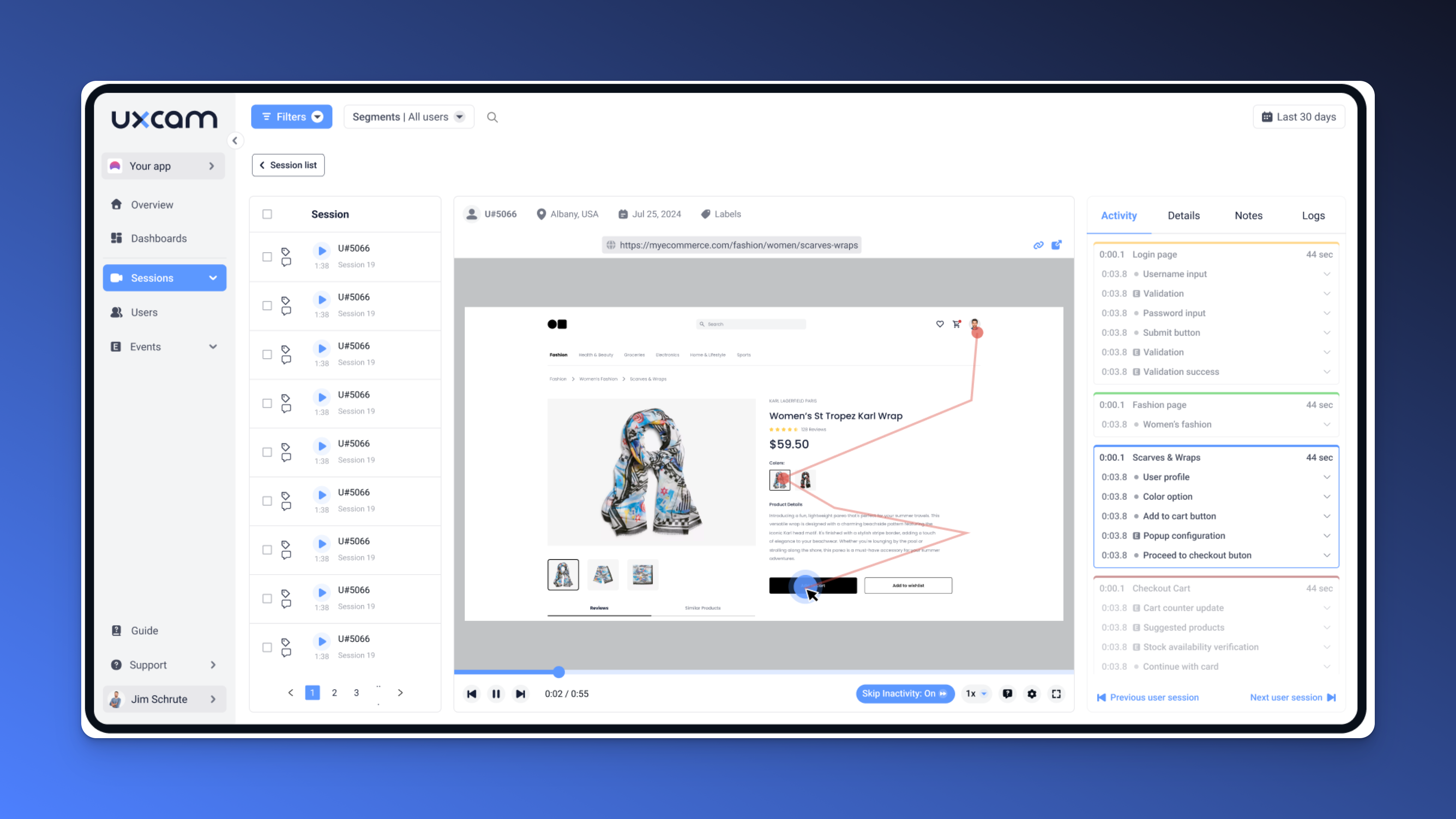

Collect feedback through micro-surveys after feature interactions
Users won’t always tell you what’s confusing them—unless you ask. Micro-surveys give you direct insights into their experience while they’re still engaged.
Trigger a one-question survey after users try a new feature to gauge satisfaction.
Ask why users didn’t complete a certain action, helping you identify blockers.
Use a simple thumbs-up/thumbs-down prompt to track how useful tooltips or guides are.
This feedback helps you continuously refine onboarding and engagement strategies, improving adoption over time.
6. Track the Right Adoption Metrics
SaaS product adoption isn’t about gut feelings—it’s about data-driven decisions. If you’re not tracking the right metrics, you won’t know what’s working and what needs fixing.
To optimize adoption, focus on key indicators that reveal user engagement, feature adoption, and friction points.
Monitor DAU/MAU to measure engagement trends
Daily and monthly active users (DAU/MAU) show you how often users return. A low DAU/MAU ratio means users aren’t engaging consistently—a sign they aren’t finding enough value.
If DAU is dropping, examine whether onboarding is too complex or feature adoption is low.
Compare DAU/MAU over time to see if users stick around after sign-up.
Segment data by user cohorts (e.g., new vs. existing users) to uncover trends in long-term engagement.
Analyze feature usage rates to identify underutilized tools
Not all features are equally valuable to users. If a key feature has low adoption, it could mean:
Users don’t understand its purpose.
It’s too difficult to access or set up.
There’s no clear benefit shown during onboarding.
Tracking feature usage analytics helps you spot underperforming tools and refine your product positioning and onboarding flow.
Use conversion funnel drop-offs to detect friction points
If users abandon your product at key stages (e.g., during onboarding or setup), something is blocking adoption. UXcan's session replay and funnel analysis can reveal:
Where users drop off during sign-up or onboarding.
If they attempt but fail to complete certain tasks.
Which steps cause confusion or frustration.
For example, if many users drop off right before activating an integration, there may be a missing tutorial or an unnecessary step creating friction.
By continuously tracking adoption metrics, you can pinpoint where users struggle, refine your onboarding strategy, and keep engagement high.
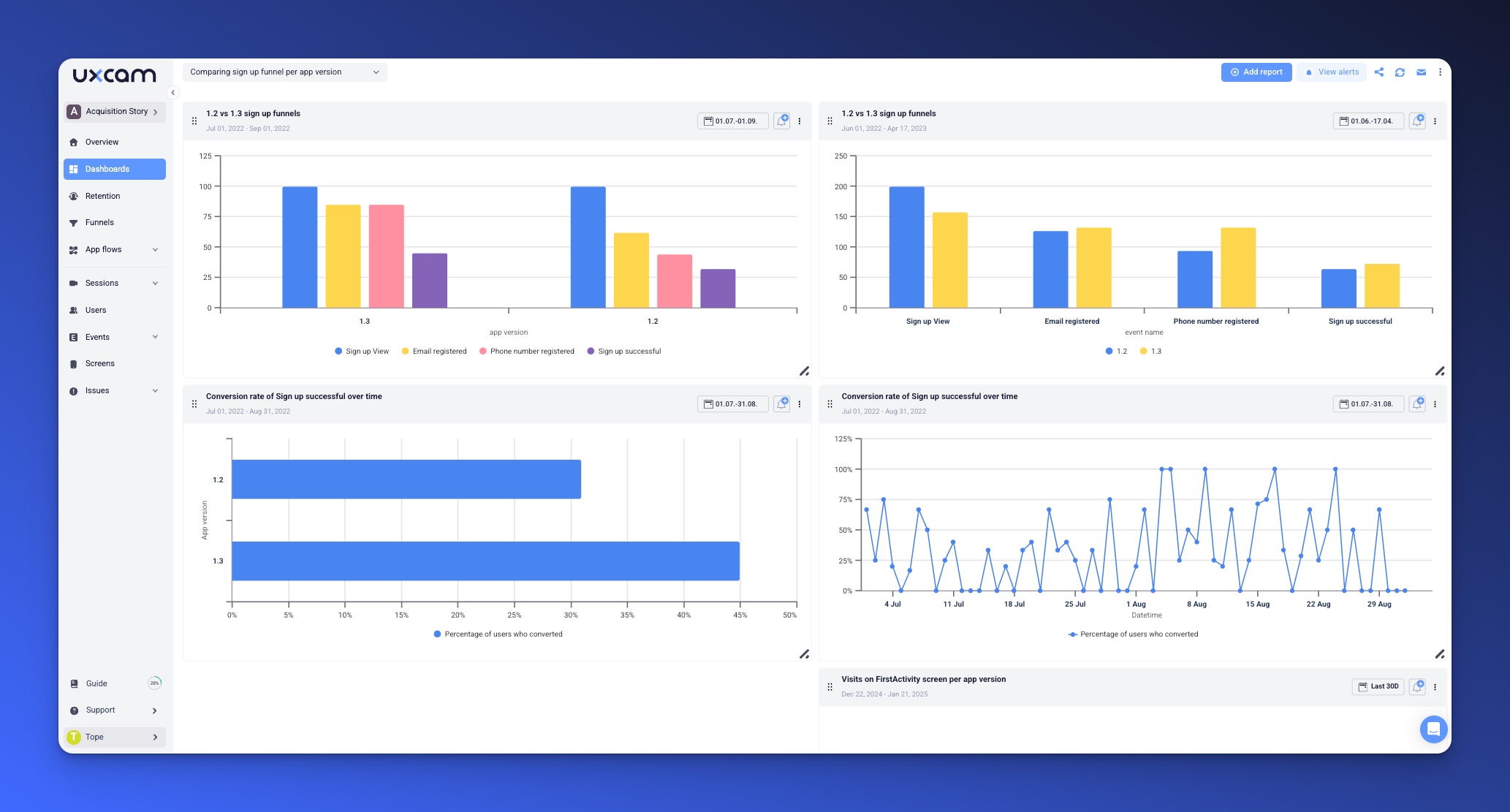

7. Create feedback loops for continuous improvement
Your users are your best source of insight. They know what’s working, what’s confusing, and what’s missing. But if you’re not actively listening, you’re flying blind. Building continuous feedback loops ensures your product evolves in ways that truly serve your users.
Instead of guessing what users want, create structured ways to collect, analyze, and act on feedback. Here’s how to do it effectively:
Send regular surveys to gauge satisfaction and pain points
Don’t wait for users to complain. Proactively ask them about their experience.
Use NPS (Net Promoter Score) surveys to measure overall satisfaction and likelihood to recommend.
Send feature-specific surveys after users interact with key tools to see what’s helping or frustrating them.
Run exit surveys for users who churn to uncover the biggest friction points.
For example, you can use Survicate to can collect real-time feedback without interrupting the user experience.
Offer beta testing opportunities for loyal customers
Your most engaged users often have the best ideas for improvements. Involve them early in new feature development.
Create a beta testing group where users can try upcoming features before launch.
Offer exclusive access to power users in exchange for structured feedback.
Use session recordings and heatmaps to see how beta testers actually interact with new features.
This approach not only refines your product before launch but also turns beta testers into advocates.
Close the loop by implementing and communicating product changes
Nothing frustrates users more than giving feedback and seeing no action. Make it clear that their input matters.
Keep a public changelog showing which user-suggested improvements have been implemented.
Personally reach out to users who submitted feedback to inform them of updates.
Highlight improvements in in-app messages, emails, and release notes so users see the impact.
Companies like Slack and Notion excel at this, consistently rolling out user-driven updates and ensuring customers feel heard.
8. Keep users engaged with regular product updates
Stale products lose users. If your SaaS tool isn’t evolving, customers will look for alternatives that offer better features, a smoother experience, or simply more excitement.
Regular updates keep engagement high, increase retention, and reinforce product adoption over time. But how you roll out updates matters just as much as the updates themselves.
Share an open product roadmap to build trust and anticipation
Users appreciate transparency. Showing them what’s coming next keeps them invested in your product.
Maintain a public roadmap where users can see planned updates and upcoming features.
Let users upvote or comment on feature requests, making them feel involved in development.
Use email and in-app notifications to keep users excited about future improvements.
Companies like Trello and Linear use transparent roadmaps to keep users engaged and eager for what’s next.
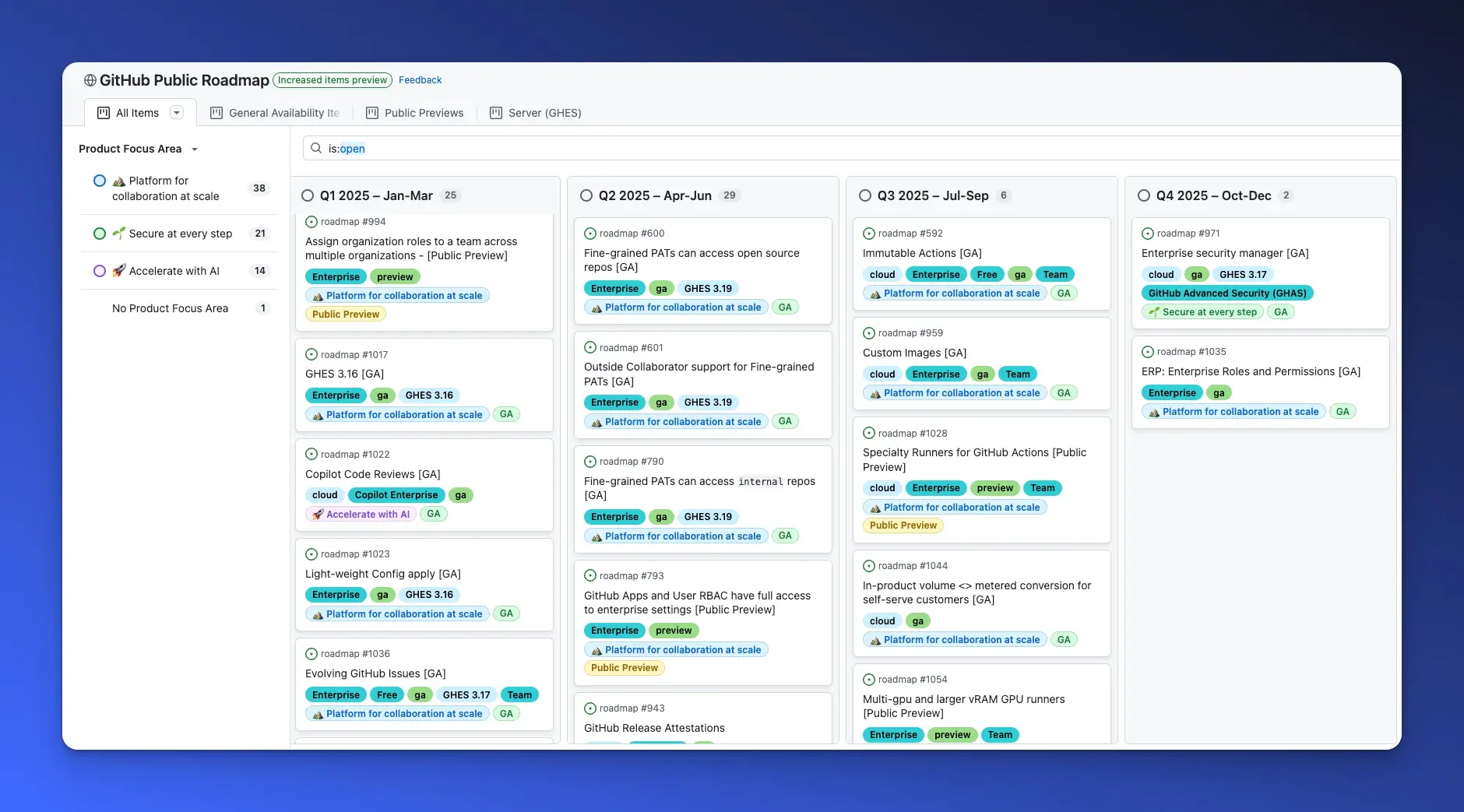
Release frequent, incremental improvements instead of massive overhauls
Users don’t want to relearn your product overnight. Gradual improvements are easier to adopt than drastic redesigns.
Roll out small updates regularly to avoid overwhelming users.
Use A/B testing to introduce changes gradually and measure impact before full deployment.
Let users opt into new features early, so they feel in control of the experience.
For example, Gmail allows users to toggle between new and old UI versions before enforcing major changes—reducing frustration.
Clearly communicate feature updates and their benefits
A new feature is useless if users don’t know it exists or how to use it. Communicate updates in a way that highlights real benefits.
Announce updates with in-app tooltips, banners, and walkthroughs to ensure visibility.
Use release notes and blog posts to explain how new features solve specific pain points.
Offer short video demos to show features in action, rather than just describing them.
Figma, for example, embeds concise “What’s New” pop-ups directly into the app, ensuring users discover new features without effort.
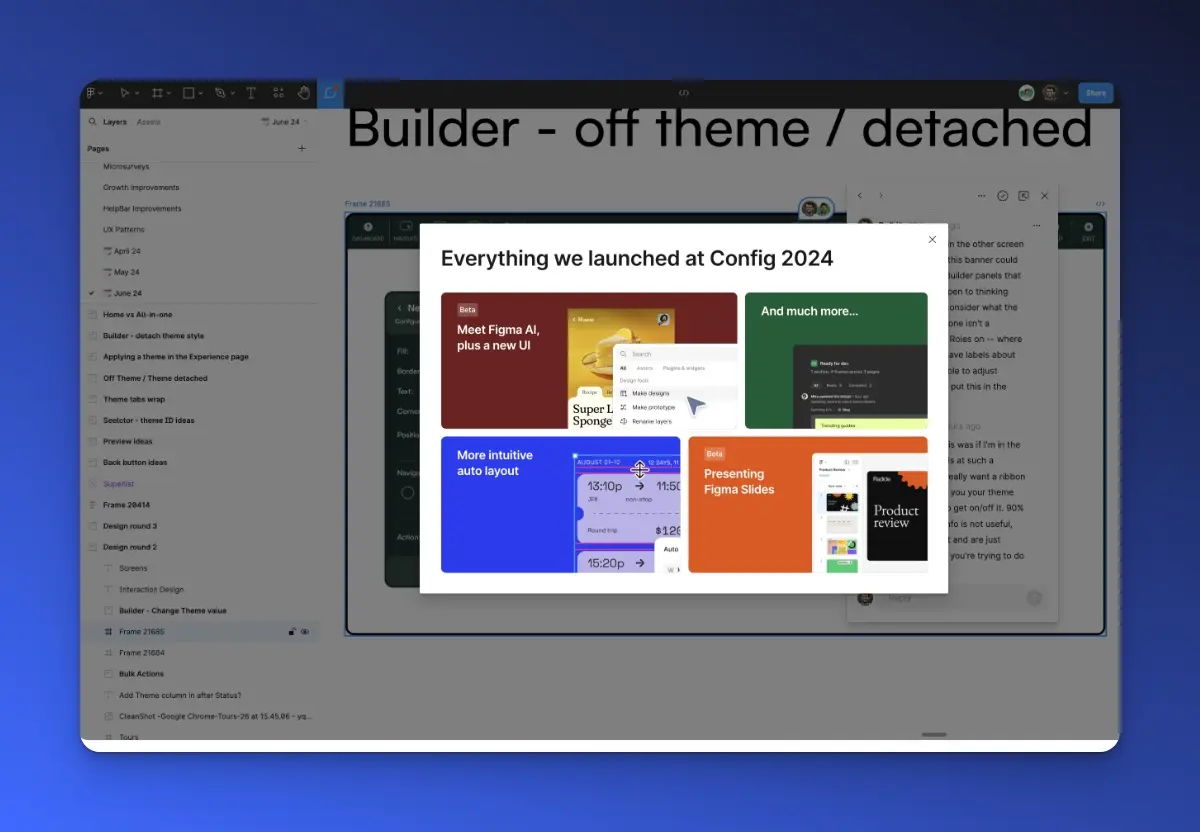
9. Simplify feature adoption with contextual guidance
Rolling out new features is one thing. Getting users to adopt them is another. If users don’t immediately see how a new feature benefits them, it will go unnoticed—no matter how valuable it is.
The key is to introduce features within the right context so users naturally integrate them into their workflow. Instead of forcing them to explore on their own, guide them at the moment they need it most.
Highlight new features with in-app announcements
A feature launch without visibility is a wasted effort. Users need to know what’s new and why it matters.
Use in-app banners or pop-ups to announce new capabilities.
Keep announcements short and focused on benefits—not just technical details.
Offer a “Try Now” button to encourage immediate interaction.
For example, Slack introduces new features with a simple tooltip and a call-to-action, making discovery effortless.
Provide use-case-based tutorials instead of generic help docs
Users don’t care about how a feature works—they care about how it helps them.
Create role-specific guides that show how the feature solves problems for different user types.
Use step-by-step walkthroughs that integrate seamlessly into the app.
Include video snippets or GIFs for visual learners.
For instance, UXCam’s session replay feature becomes much more useful when paired with an in-app tutorial showing how to analyze drop-off points.


Offer milestone-based progress tracking to encourage deeper adoption
Users are more likely to adopt a feature when they see clear progress and rewards.
Implement checklists or progress bars that guide users toward full feature adoption.
Send nudges when users complete key actions, encouraging them to explore further.
Reward engagement with small wins, like a badge or in-app recognition.
For example, Duolingo’s streak tracking keeps users engaged by making progress visible and rewarding consistency.
10. Reduce friction in the user journey
Even a small obstacle can stop users from adopting your product fully. Complex workflows, unnecessary clicks, or confusing steps can frustrate users and lead to drop-off.
The smoother the experience, the higher the adoption. Identify and eliminate points of friction before they become barriers.
Identify and remove unnecessary steps in key workflows
Users expect efficiency. If they struggle to complete basic tasks, they’ll abandon the process or look for alternatives.
Use session replay analytics to spot where users get stuck.
Remove redundant clicks and forms that slow users down.
Automate repetitive steps where possible.
For example, if users consistently drop off during setup, simplifying the form fields or adding auto-suggestions could improve completion rates.
Offer self-service troubleshooting to reduce support reliance
Most users prefer to solve problems on their own rather than submit a support ticket.
Embed helpful tooltips, FAQs, and interactive troubleshooting guides directly in the app.
Offer chatbots or AI-driven support for common questions.
Let users search support articles without leaving the app.
Notion does this well by providing instant help suggestions when users type in the search bar, reducing friction in problem-solving.
Ensure a seamless mobile and desktop experience
Users switch between devices constantly. A clunky mobile experience can kill adoption, especially if your SaaS product is used on the go.
Optimize touch-friendly navigation and responsive layouts for mobile users.
Keep workflows consistent across devices, so users don’t have to relearn processes.
Enable cloud syncing to ensure seamless transitions between desktop and mobile.
For example, Figma’s cross-platform consistency allows users to work effortlessly across devices without losing context.
11. Encourage power users to drive organic growth
Your most engaged users aren’t just customers—they’re potential advocates. When users love your product, they naturally share it with others. But to maximize this effect, you need to identify, nurture, and empower these power users to spread the word.
A strong user advocacy program builds trust, credibility, and long-term brand loyalty. Here’s how to make it happen:
Identify engaged users and turn them into brand advocates
Not all users are equally engaged. Some only use the basics, while others explore advanced features, share feedback, and actively contribute to your community. These are your power users—and they can be your best marketing asset.
Track feature adoption, session frequency, and engagement levels to spot highly active users.
Invite them to beta programs, advisory boards, or VIP communities to deepen their connection with your brand.
Recognize their contributions with badges, exclusive content, or early access to new features.
For example, Notion runs a "Notion Ambassadors" program, where engaged users get exclusive perks while helping spread product knowledge.
Incentivize referrals and user-generated content
People trust recommendations from real users more than ads. A well-structured referral program turns happy customers into your most effective sales channel.
Offer discounts, free months, or feature upgrades for users who refer new customers.
Create leaderboards or gamified rewards to encourage ongoing participation.
Ask engaged users to share templates, workflows, or integrations that help others maximize the product.
A great example is Dropbox’s viral referral program, which rewarded both the referrer and the new user with extra storage—leading to massive growth.
11.3 Promote Customer Success Stories and Case Studies
Your best customers already have real-world success stories with your product. Showcasing their wins makes your product feel more valuable and relatable to potential users.
Feature case studies highlighting measurable results from power users.
Showcase testimonials and success stories in blog posts, videos, or social media.
Encourage users to share their experiences in webinars, live Q&As, or community events.
For example, UXCam’s customer success stories help prospects see how real teams solve usability issues and improve product adoption with session replays.
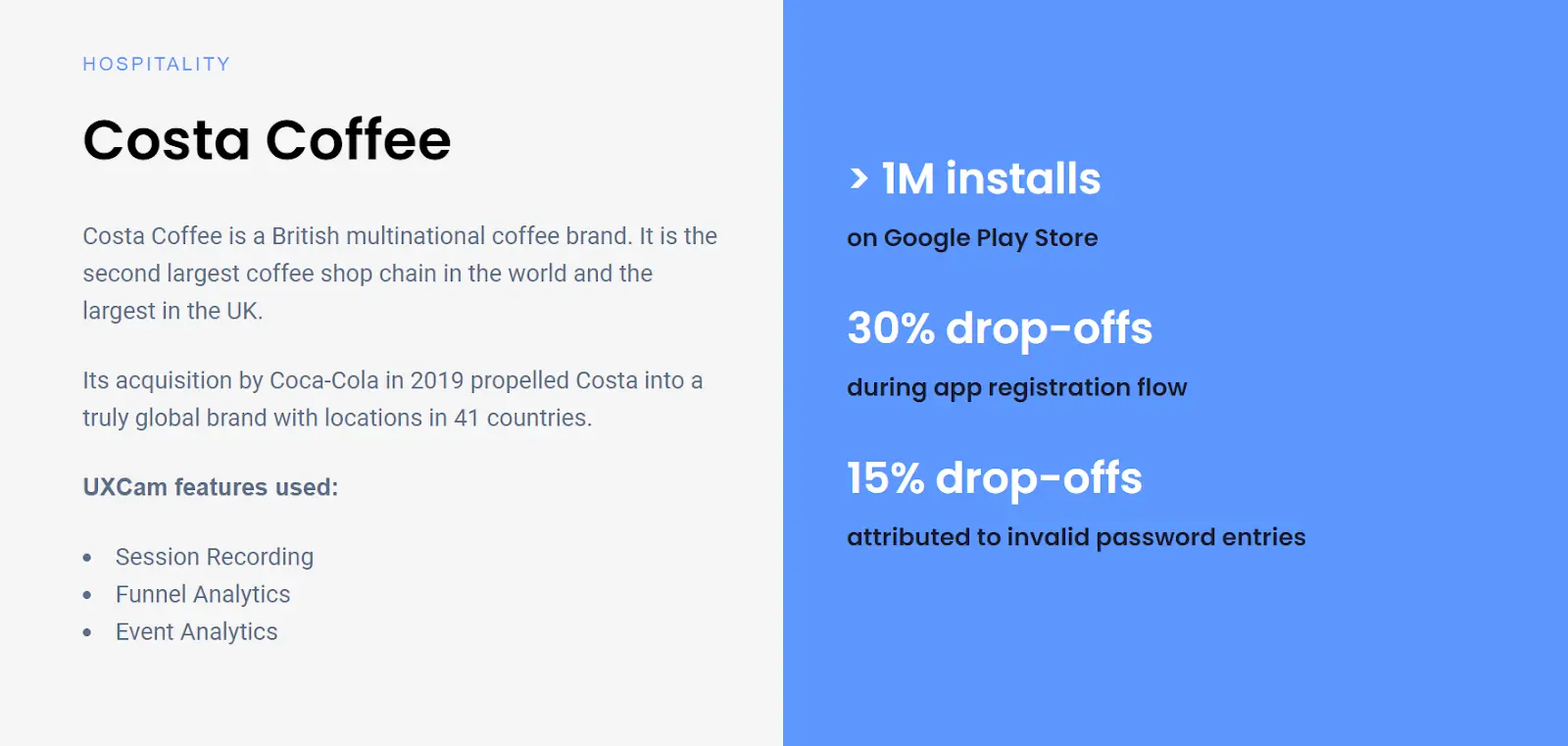
Conclusion and next steps
Driving SaaS product adoption is all about creating a seamless experience from onboarding to long-term engagement. By simplifying feature discovery, personalizing user journeys, reducing friction, and leveraging in-app guidance, you ensure users quickly see value and stay engaged.
Tracking adoption metrics, collecting feedback, and nurturing power users further reinforce growth, helping you turn satisfied users into loyal advocates.
To make data-driven adoption improvements, you need the right insights. UXCam’s product analytics for web helps you understand user behavior, uncover friction points, and optimize feature adoption.
Try UXCam for free today and start improving SaaS adoption with real user insights.
You might also be interested in these;
Best Product Analytics Software
SaaS Product Analytics: A Comprehensive Guide
Web Analytics Strategy - How to Improve Your Product with Data
How to analyze session recordings
Stages of the product adoption process - An indepth guide
How to measure product adoption (metrics, formulas & tools)
5 Best product adoption software tools to build stickier apps
AUTHOR

Tope Longe
Product Analytics Expert
Ardent technophile exploring the world of mobile app product management at UXCam.
What’s UXCam?
Related articles
Website Optimization
AI Conversion Rate Optimization - What It Is & How It Works
Boost your website performance with AI Conversion Rate Optimization. Learn how AI tools analyze behavior, personalize UX, and increase conversions...

Tope Longe
Product Analytics Expert
Website Optimization
10 Best Landing Page Optimization Tools
Boost conversions with the 10 best landing page optimization tools. Compare features, pricing, and use cases for growth-focused...

Tope Longe
Product Analytics Expert
Website Optimization
How to Improve User Experience on Website
Improve website UX with 10 proven tips for product managers. Learn how to spot issues, reduce friction, and boost conversions using UXCam for...

Tope Longe
Product Analytics Expert